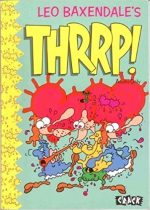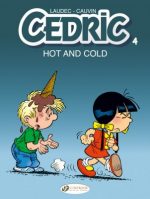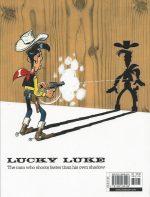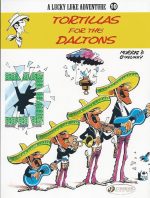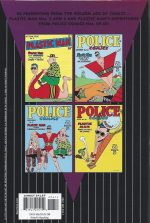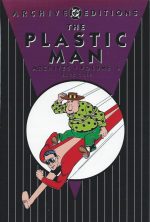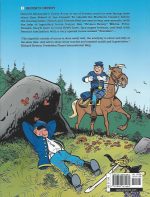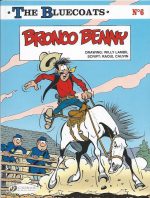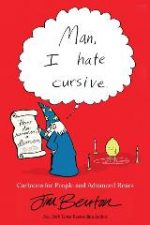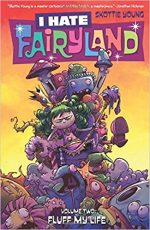
By Skottie Young, Jean-Francois Beaulieu & various (Image Comics)
ISBN: 978-1-63215-887-1
Fairy tales are so ubiquitous that you could – inaccurately (Go, Pedants!!) – describe them as part of our DNA. Some people claim to have grown out of them whilst others take them to heart and make them an intrinsic aspect of their lives, but we can all feel them (the stories, not the readers) lurking in our subconscious, sharpening axes, heating up steel dancing shoes or honing Great Big Teeth…
Well, maybe some of the readers…
There’s this guy… Skottie Young?
He’s someone with feet firmly planted in all camps and well able to alternatively embrace the enchantment of imagination and give it a hilariously iconoclastic, mean-spirited boot in the backside at the same time.
Surely, you’ll have seen his glorious, multi-award winning interpretation of Baum’s Oz books produced for Marvel, his spectacular run on Rocket Raccoon (and Groot) or at least chuckled over his outrageous funny baby superhero covers…
Maybe you’re aware of his collaboration with Neal Gaiman on Fortunately the Milk.
If not, there’s so much more in store for you after enjoying this second collected slice of mirthful mythic malevolence and mayhem…
I Hate Fairyland is a truly cathartic little gem: a mind-buttering romp of deliciously wicked simplicity and one I heartily recommend as a palate-cleanser for anyone overdosing on Princess Parties, cotton candy and glitter…
Once upon a time little Gertrude wished she could visit the wonderful world of magic and joyous laughter and her wish was inexplicably granted. There she met happy shiny people, fairies, elves, giants, talking animals and animated trees, rocks, stars, suns and moons and just loved them all.
Resplendent Queen Cloudia made her an Official Guest of Fairyland and invited her to play a game. When she wanted to go back to her own world the six-year-old simply had to find a magic key and open the door to the realm of reality. The fabulous Fairy Queen even bestowed upon Gertrude a quaint talking bug as guide and helpmeet. Oh, and a magic map of all the Known Lands…
That was nearly thirty years ago and although Gert’s body didn’t age a day her mind certainly did. In fact, it got pretty damned pissed-off at the interminable, insufferable chore that looked like never ending…
As an Official Guest of Fairyland, Gert was not allowed to die and took to expressing her monumental frustration in acts of staggering violence and excess as she hunted for that fluffer-hugging key…
With no other choice, Gert and dissolute death-craving intellectual insect Larrigon Wentsworth III toiled ever onward in search of the way home, enduring horrific – but never permanently fatal – injuries and venting their annoyance (and other creatures’ vital fluids) on whoever got in the way.
Eventually even Queen Cloudia had enough but could do nothing whilst Gert maintained her Official Guest of Fairyland status… a privilege that could not be revoked…
Covertly commissioned barbarians, assassins and evil witches all filed to remedy the situation. Between the protection spell and Gert’s own ingrained propensity for spectacular bloodletting, nothing in the incredible kingdoms could stop her…
And then, just when a truly amazing idea got hatched… it got even worse.
Due to circumstances beyond anybody’s control Cloudia’s rule ended and Gert was stuck ruling the saccharine-sweet hellhole she so despised…
As we resume cartoon communication Queen Gertrude has been in charge quite long enough. Even wanton slaughter in her personal gladiatorial games and random acts of magic-fuelled drive-by exterminations cannot offset the unending tedium of the paperwork necessary to run the Realm and ‘Gert of Thrones’ is desperately looking for a way out of the endless responsibilities of rule. And then, for the first time in decades, fate falls her way and Gert is offered a way out…
It doesn’t end well for her subjects, though…
On the loose again, Gert returned to her former anti-social ways unaware that destiny was shaping a really big metaphysical cowpat for her to step in. It begins sometime in the real world she so wants to rejoin where a little kid in a dragon costume finds himself in dire need of a pitstop. Tragically for Duncan and Fairyland, that rush to the outhouse results in a little unwanted trans-dimensional tourism. Gert meanwhile has put out feelers (and many other strange critters) to locate a way back to earth. The most likely method involves the urine of mighty flying saurians but as that is the rarest thing in the Realm, it pretty fortunate that Duncan still frantically trying to unzip his costume materialises just then and learns the downside of ‘How to Drain your Dragon’…
Desperate enough to consult a soothsayer, Gert later learns of a possible escape route but glazes over the bit where the future-reader says Duncan will be the greatest monster the Realm ever saw. Eager for release – any form of release – the ex-queen finds herself fighting a chilling army of videogame foes in the oddly electronic ‘Tower of Battle’ and handed the drubbing of her unending life. The victorious games-master gives her high heave-ho but keeps little Duncan…
After losing a high stakes card game Gert then has to enter her own infinitely capacious magical Hat of Holding in search of an item to pay off her debts. Unfortunately, thanks to her slovenly habits, that means dealing with the infestation of marauding Lynts which has built up amidst the decades of “acquired†artefacts, treasures and people who have annoyed her resulting in a pretty messy case of ‘Splat in the Hat’…
Closing up shop for the nonce is a tale of salutary warning as Gert and Larry enter a mystic manse to be confronted by a choice of two portals, one leading to her heart’s desire and the other to an outcome of horrific consequences. Never big on thinking things through, Gert is stymied…
You’d think she might listen to her shattered and battered future-self, suddenly come back from a apocalyptically hell-shocked dystopian tomorrow with a message of warning and explicit instructions. You would? Then you really haven’t grasped the gist of this savagely surreal saga, have you?
And yet… somehow… To Be Continued…
Collecting issues #6-10 of I Hate Fairyland, (from March-October 2016) the sublimely subversive saga continues courtesy of Young, colourist Jean-Francois Beaulieu and letterer Nate Piekos of Blambot®: a cornucopia of cartoon ultra-violence and side-splitting mythic irreverence hilariously utilising the most imaginative and inspired use of faux-profanity ever seen in comics. There’s even a bunch of variant covers to drool over, if your nerves and stomach can stand it…
This is an unmissable wakeup call for everybody whose kids want to be little princesses and proves once and for all that sweet little girls (and probably comics artists) harbour hidden depths of depravity and barely-suppressed aggression…
© 2016 Skottie Young. All rights reserved.

